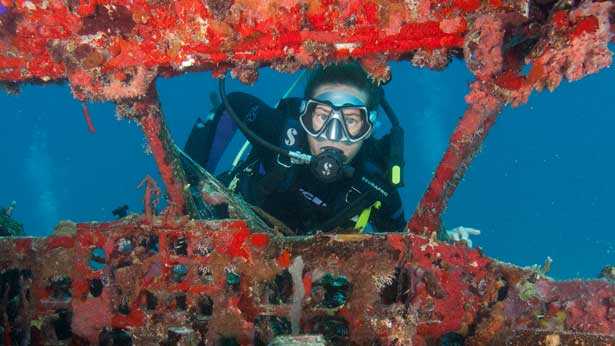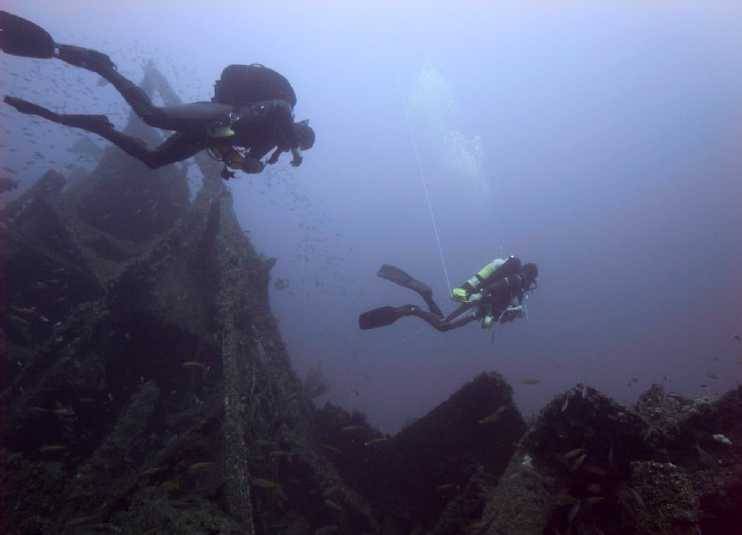
There is something terribly exciting about losing yourself in the crumbling carcass of a shipwreck. Each wreck is tale of storms and scuttled hulls. The treasure found in these skeletons are not gems and gold, but equally special with colourful coral, nudibranchs and vibrant marine life. We’ve adventured along Africa’s coast to find the most beautiful, most interesting shipwrecks and wreck dives in Africa.
The 3 different types of wreck diving
Wreck diving is often subdivided into three types:
- non-penetration: swimming over and around the wreck,
- limited penetration: going into an overhead environment, subject to a limit of about 40 metres cumulative linear distance to surface (which really just means the depth plus length of penetration),
- full penetration: going deeper into the overhead environment in the wreck.
Our Top 10 Wreck Dives in Africa
1. The Maori

The Maori is located between Hout Bay and Llandudno, in the Cape Peninsula, about 75 metres offshore. The Maori’s history is a fascinating one – the ship was carrying a cargo of explosives, water piping and crockery from London to New Zealand when it crashed into the rocks in thick fog on 5 August 1909. Though the marine life is not as colourful as on other dives, The Maori is renowned for its historical value and divers can expect to see bits of porcelain and bottles still located in this sunken treasure.
2. The Paquita
Knsyna Heads is a magnificent setting for a scuba diving adventure. The Paquita, a German vessel, sank on the eastern side of the Knysna Heads way back in 1903. Divers exploring the Paquita wreck can go as far as 16 metres below the surface. The wreck remains in excellent condition. Its iron plates still glimmer brightly and its anchors are clearly visible, despite sitting at the bottom of the ocean for over a century. Divers can expect to see the famous Knysna seahorses, nudibranchs, blacktails and an assortment of other fish.
What’s scuttling?
No, we’re not talking about crabs this time. Scuttling is the act of deliberately sinking a ship by allowing water to flow into the hull. This can be achieved in several ways—valves or hatches can be opened to the sea, or holes may be ripped into the hull with force or explosives. Scuttling is often done to provide an artificial reef for divers and marine life.
3. Smitswinkel Bay Wrecks

The wrecks in Smitswinkel Bay off the Cape Peninsula were scuttled by the navy to form artificial reefs, a sort of haven for divers. And what a haven it is! You will find the SAS Transvaal and SAS Good Hope – former navy frigates, the Rockeater – a diamond dredger, which lies deep (at 36m) and boasts an abundance of life and colour; and two fishing trawlers – The Princess Elizabeth and The Oratava. Teeming with fish, nudibranch and coral life, the wrecks are fairly deep, which means that artificial light is needed to see the wonderful colours of the marine life.
4. The Produce

The Produce was travelling from Durban, South Africa, headed south when it struck the Aliwal Shoal in 1974. The old cargo vessel was allegedly thought to be carrying molasses. The Produce is 119m long and lies facing North. The vessel is home to a host of Giant Brindle Bass, which are massive fish about 3m long, and 1.5m wide – spotting one of these giants is a treat in itself. This dive is considered to be the crowning jewel of the Aliwal Shoal dive sites on a good day.
5. The Klipfontein

The Klipfontein shipwrecked off the coast of Mozambique in 1953 after hitting a reef off Zavora beach. With a depth of between 34m and 52m, Klipfontein lies about 6km offshore, roughly halfway between the deep offshore reef system and the red and white sands system. In her prime she was 160m long but split in two on her descent into the depths. Both parts of the wreck offer stunning deep water artificial reef dives. It’s definitely worth a dive.
6. SS Paraportiani
The SS Parapotiani is a fascinating dive. The 300 ft-long cargo vessel lies in less than 60 feet of water, off the Panza Reef at the southern tip of Pemba Island, Zanzibar. What makes this dive unique is that fact that the ship’s stern is still largely intact and her broken superstructure is now embedded in the sand. This is a shallow dive and perfect for novice divers. The skeleton of this vessel is alive with elegant lionfish, colourful anemone and starfish who have made the reef their home.
7. Ennerdale wreck
Ennerdale Wreck lies off the coast of Mahé – the largest island in the Seychelles. She went down in 1970 when she struck a pair of uncharted granite pinnacles off Mahé island. This is a tricky dive, but worth the challenge and recommended for more advanced divers. With a maximum depth of around 30m, the site is known for its abundance and variety of tropical fish and marine life, just waiting to be explored.
8. Djabeda Wreck
The Djabeda wreck is a Japanese fishing boat, sunk just off the Coin de Mire (Gunner’s coin) Island on the north coast of Mauritius in 1998. The wreck has been only slightly damaged over the years and debris can be seen strewn across the sandy ocean bed. The vessel is approximately 44m long, 10m high and 5m wide and stands upright in a maximum of 34m depth. As part of the dive you will pass some wreck parts, some of which are kept safe by giant morays. Look out for the huge anchor. On the dive you are likely to see an amazing coral garden rich with soft corals, schooling fish, king fish, moray eels, trigger fish, stone fish, lion fish, parrot fish, leaf fish and sea slugs – and if you’re lucky barracuda, sting rays and dolphins.
9. Stella Maru
The Stella Maru is a Japanese trawler that was sunk in 1987 by the Mauritius Conservation society to create an artificial reef. The Stella Maru wreck lies upright on a sand bottom, next to a rocky reef at an average depth of 23 metres. Unlike many other wrecks, the ship lies virtually intact on the ocean floor, offering divers a remarkable, unrivalled sight as they descend toward it. Other attractions are the giant moray eels and the number of bottom-dwelling creatures lying unseen around the wreck or in cervices and recesses in the coral patches surrounding it.
10. Mitsio
For those looking for nighttime wreck dives in Africa, The Mitsio off Madagascar’s Nosy Be coastline is the ideal African wreck dive. Down at 25m, the wreck is home to throngs of lion and devil fire fish, arrow crabs and a dazzling honeycomb moray, hiding on the starboard side. It is a colourful, vibrant dive, as the coral growth on the wreck, which sank in 2008, provides a home to a plethora of species and an exceptional diving event.
Let’s go discover the best wreck dives in Africa!

Start your underwater safari today! Let Rhino Africa tailor-make your African holiday of a lifetime to suit your budget, needs and style. One of our experienced consultants will give you all the inside information to ensure you get the best possible wreck dives in Africa. Get your flippers on and contact us today!
- In case you missed the first installment of our Underwater Series – read Africa Underwater: Our Top 5 Reefs in South Africa.